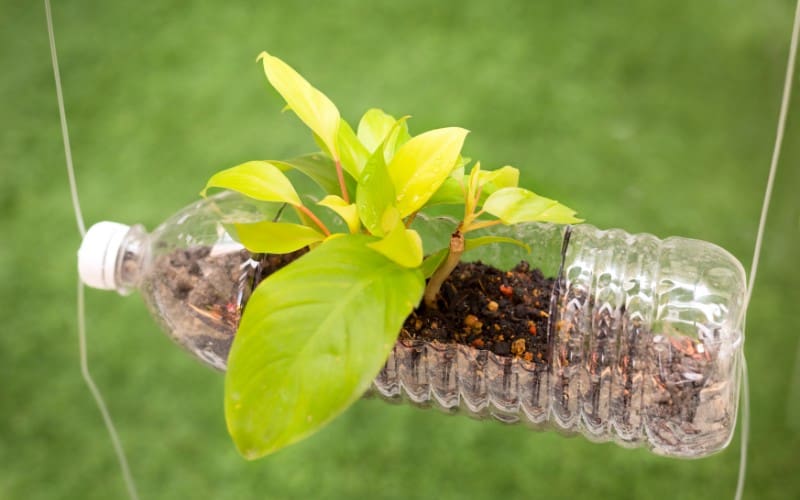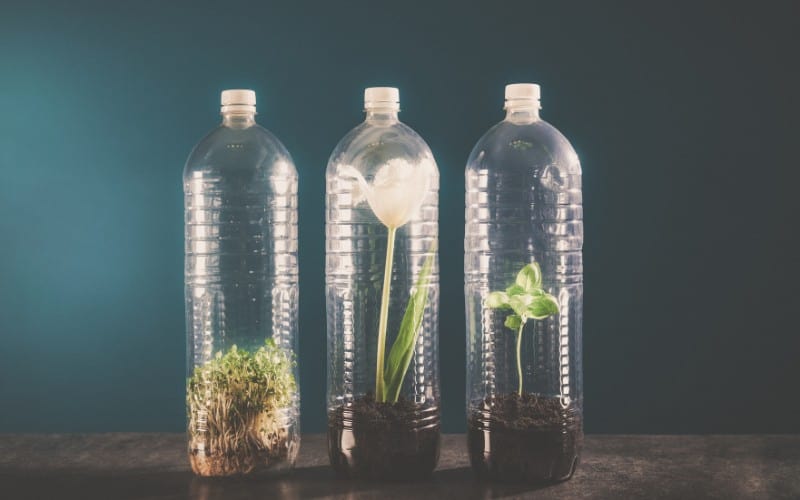In recent times, growing plants in plastic bottles seem to be the new trend. Environmentalists believe that using plastic bottles for plants will combat some adverse effects plastic bottles have on the environment.
Be it as it may, the growing of plants in plastic bottles is not exactly a recent trend. It is common to grow plants in plastic bottles from our high school days by filling the bottle with soil and water; these plants thrived most often than not.
In today's post, you're going to learn how to grow plants in plastic bottles. We will also look at some of the plants that you can grow in a plastic bottle.
Let's get started!
Table of Contents
Is Growing Plants in Plastic Bottles Harmful?
Note that not all plastic bottles are suitable for growing plants. Some plastic bottles are harmful and may transfer toxins to the soil if exposed to heat and sunlight for a while. The more reason you need to know which plastic bottles are good for growing plants.
Best Plastic Bottles to Use for Growing Plants
So before you rush to grow your plants in plastic bottles, know the composition of the bottles. As earlier noted; some plastics comprise substances that are not safe for consumption.
The four brands of plastics that are suitable for growing plants at home are:
- PET
- HDPE
- LDPE
- PP
How to Grow Plants in Plastic Bottles

You don’t have to spend your hard-earned money on extravagant containers when you can use a soda bottle. Cut the soda bottle in half.
Remember that we mentioned that some plastic bottles could be quite toxic to the plant. If you can’t find the recommended bottles outlined in this post, you can opt for any plastic bottle provided that you do not let the soil dry all the time.
Place the bottle in a sunny spot in your home. If there is no bright spot in your home, you turn them upside down.
This alternative method is best suited for smaller bottles because smaller bottles need more water in the summer, and plants struggle when there are insufficient soil and excess heat and moisture.
You can use cotton when roots appear, because, at this stage, the plant requires a lot of nutrients.
Steps in Growing Plants in Plastic Bottles
We have already established that plants can thrive in plastic bottles and have guides on using plastic bottles in growing your plants.
Thus, you need to know the right steps to take in growing plants in plastic bottles, and they include the following;
- Get the right plastic bottle that will not be harmful to your plants.
- Make a hole in the bottle cap, or cut an X for drainage.
- Fill the inverted top half with soil and place it inside the bottom half.
- Add your growing medium.
- Fill the bottom half with fresh water.
- Plant your seed
- Water regularly and place in a sunny spot.
Which Plants Can Be Grown in Bottles?
To start with, all plastic bottles are not good for growing plants. Similarly, not all plants are grown in plastic bottles. To help you on which plants you can grow in plastic bottles, we will highlight the plants below and how you can grow them.
1. Basil
Basils can be grown indoors and outdoors. If you decide to grow basils indoors in a plastic bottle, put the basil cuttings in water for a few days until roots start to appear.
Transfer the cuttings to the well-prepared plastic bottle, which must be filled with the best potting soil. Place the plant in a sunny spot in your home.
2. Parsley
Parsley is best grown in small spaces with partial sunlight. These features make parsley perfect to be planted in a plastic container. The soil in the plastic container should be moist and wet. Remember not to over-water your parsley plant.
Parsley is quite useful as herbs and can be added to our dishes and known for its refreshing taste. Parsleys are best planted as seeds and thrive better in winter.
3. Strawberries
Strawberries can be planted during any season, and most importantly, they can be grown in a plastic container. If you can't find a sunny spot in your home to place your strawberry plant, you can set it under artificial light.
The best type of potting soil should be used for planting strawberries, so make sure your plastic container is filled with the best potting soil.
When your strawberry plants start to produce fruits, make sure to harvest them immediately to make space for new fruits.
4. Oregano
If you are a fan of Oregano plants, well, here is some good news, they can be grown in a plastic container. You can start by growing Oregano seeds or store-bought Oregano cuttings.
Like basil, the Oregon plant should be placed in water for a few days before being transferred to a plastic bottle.
5. Rosemary
Just like Oregon and basil. Rosemary can be planted in a plastic bottle. The only difference is that rosemary thrives in an acidic environment; thus, it is advised that some sand be added at the bottom of the bottle.
Remember to water the plant regularly, as dry soil might impede the growth of the plant.
6. Pepper
Only small peppers are suitable to be planted in a plastic bottle as big peppers require more space or, at the very least, a big container of a plastic bottle.
Pepper is a sun-loving plant; this follows that your peppers require at the very least 8 hours of sunlight per day. Gardeners recommend that you start with pepper cuttings instead of the seeds; this will save you a lot of time.
7. Spinach
Spinach can also be planted in plastic bottles. Just make sure that the bottle is at least 8+ inches of height. Spinach doesn’t necessarily need sunlight; you can place it in a shady part of the house.
Spinach is both an indoor and outdoor plant. Fill the container with good potting soil, sow a few spinach seeds, and regularly remember water.
Recommended Readings:
- How to Grow Spinach In Pots
- How to Grow Strawberries In Pots
- How To Grow Turnip Greens In a Container
- How To Get Root Bound Plants Out of Pots
Conclusion
Using plastic bottles to grow your plants is actually quite effective; not only does it save you the cost of investing in expensive planting jars, but it's also a way to protect the environment from the nuisance caused by plastic bottles.





